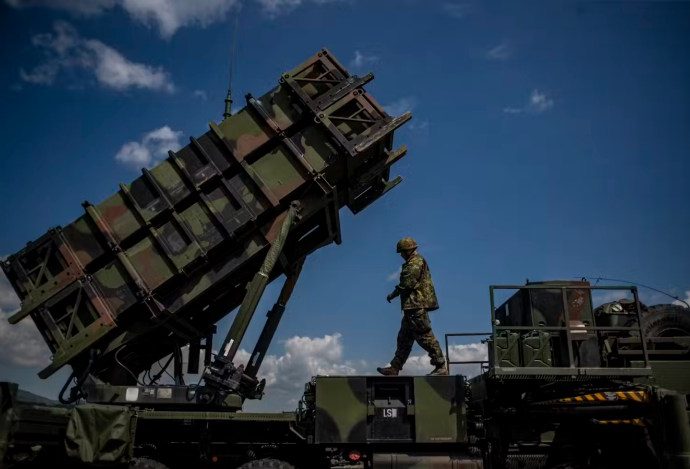Could war in Gaza ignite direct US-Iran confrontation? – Asia Times
Increasingly, there have been signs of Israel’s current military operations expanding violence beyond Gaza. Such prognoses became compelling after last week’s military strikes by the US and its allies on more than 60 locations under Houthi command and launch centers across Yemen, followed by Iranian strikes on Iraq, Syria and Pakistan.
The US has since re-designated the Houthis as global terrorists. This drift away from the hyperactive US shuttle diplomacy to contain this conflict has dangerous implications beyond this energy-rich but volatile region.
The US no longer has to worry only about the Houthis’ missile strikes on merchant vessels in the Red Sea that connects the Mediterranean to the Indian Ocean, accounting for 15% of global shipping and one-third of global container trade.
What the West calls Iran’s “Axis of Resistance” – which includes the Houthis in Yemen, Hezbollah in Lebanon and similar groups in Syria and Iraq – have been carrying out attacks on Israel and its allies to express solidarity with Palestine. The Houthis have been attacking merchant ships in the Red Sea since November to pressure Israel to allow the free flow of humanitarian aid into Gaza and for an early end of hostilities.
Of course, the Houthis’ promise to attack only Israel-linked shipping has not been possible, as it is never easy to identify a merchant ship with one nation even when it is legally identified by the flag of that country.
This crisis has caused severe disruptions, with shipping companies’ re-routing resulting in delays, uncertainties and fee increases. But what the United States has to worry about now is Iran’s direct military strikes, which have raised the specter of a possible direct US-Iran confrontation long in the making. At the least this new phantom threatens to derail diplomatic efforts to contain the conflict within Gaza.
Specter of military strikes
Weary of continued Houthi strikes in the Red Sea, several nations, including India, have taken measures to provide escorts, intelligence and rescues for merchant shipping in this theater. In December the United States constituted a nine-nation task force named Operation Prosperity Guardian. This has enormously increased the presence of warships in these waters, and yet the problems have not subsided.
Now, last week’s barrage of retaliation from the US and its allies has been followed by Iranian inland military strikes, first on Iraq and Syria and then inside Pakistan.
It appears that after bomb explosions in Kerman in southern Iran this month, Tehran is no longer relying only on its so-called proxies alone. President Ebrahim Raisi’s political deputy Mohammad Jamshaidi was quick to blame Israel and the US for the Kerman bombings, though Islamic State (ISIS) soon claimed responsibility for the attacks, which killed more than 100 people.
But can the United States, in the midst of a presidential election season and in the face of wars in Ukraine and Israel, afford a direct confrontation with Tehran and its allies? Especially so, when the Israeli war in Gaza has killed more than 24,000 Palestinians, galvanizing intransigence if not open pan-Arab support for Palestine?
Not that the US has discarded diplomacy as its first choice, yet these expanding military strikes surely betray fatigue among its partners, thus complicating its diplomacy.
The US-led nine-nation Operation Prosperity Guardian, for example, has not been joined by several of its close Indo-Pacific allies. These include Australia, Japan and several of its Arab allies, including Saudi Arabia, which has been fighting the Houthis for decades.
The world’s largest trading nation, China, has not joined it either. Meanwhile, Iran launching direct strikes does not mean that Hezbollah and the Houthis have stopped shooting missiles, incrementally intensifying regional tensions. If anything, they remain keen on spreading it wider as well.
Expanding confrontation
The Houthis, for example, have now taken it all the way from Red Sea to the Gulf of Aden. Also, more than Israel, last week’s US-led attacks were followed by the Houthis this week launching fresh attacks on US commercial vessels as well.
Together, these military attacks have reportedly impacted more than 50 countries’ shipping, disrupting global supply chains and igniting doomsday speculations.
Iran’s direct military strikes have triggered scenarios of a wider confrontation involving other nations. This Monday saw Iran’s Islamic Revolutionary Guard Corps (IRGC) launch ballistic missiles at what it calls Israeli “spy headquarters” in Iraq’s Kurdish region and hit targets linked to ISIS in northern Syria.
Tuesday saw the IRGC using drones and missiles to hit at Salafi-Sunni insurgents of Jaish al-Adl (Army of Justice) inside Pakistan, thereby involving a nuclear-armed state of South Asia.
The Pakistan Navy has also deployed its warships in the Arabian Sea, and last Sunday claimed to have rescued 21 crew members from a merchant vessel after a hijacking distress call.
Pakistan, which has been a close ally of the United States but also a close friend of China and Iran and a major stakeholder in the Middle East, has so far steered clear of the Gaza conflict, focusing on its own merchant ships and even clarifying that its naval deployments are not meant to counter the Houthis.
But Iranian strikes in Balochistan have pulled Pakistan into this expanding confrontation. A Pakistani Foreign Ministry spokesman responded by saying, “This violation of Pakistan’s sovereignty is completely unacceptable and can have serious consequences.”
It has forbidden the Iranian ambassador, on a visit to Tehran, to return to Islamabad. On Thursday, after the Iranian attacks in Balochistan, an IRGC colonel was shot dead in Iran’s Sistan-Balochistan region, with no clarity on who was behind the murder.
In December a senior IRGC adviser was killed by Israeli air strikes outside Damascus. Tensions could deepen further.
Iran-Pakistan tensions
Jaish al-Adl, with sanctuaries in Pakistan, has been launching attacks against Iranian border guards since it was set up in 2012 and has previously claimed bombings and kidnappings of Iranian border police.
The leader of this Salafi-Sunni movement in southeastern Iran, Salahudin Farooqui, has been a vocal opponent of Iran’s support of Syrian President Bashar al-Assad. They are also known for being closely linked to the Kurdish freedom movement, which could potentially bring in Turkey as well.
On Tuesday, Iran’s IRGC launched an assault on two of Jaish al-Adl’s military bases inside Pakistan’s Balochistan province. This involved the use of missiles and drones targeting the two bases but also killed two innocent children and injuring three other girls. However, both the US and China – closest of friends of Pakistan – have advised restraint and dialogue.
Given Pakistan’s current politico-economic situation and its track record of non-action against India’s air strikes on Balakot in 2019 or the American operation against Osama bin Laden in Abbottabad in 2011, Islamabad is not expected to retaliate against Iran. Pakistan has troubles on its borders with Afghanistan and India as well.
Plus, as two Islamic republics, Iran and Pakistan have had an enduring history of working together on their shared challenge from these insurgencies on both sides of their 1,000-kilometer-long border.
Iran was the first country on August 14, 1947, to recognize the Pakistani state. Both have continued to make efforts to fight insurgencies and the drug trade jointly on their shared border regions.
Diplomacy on crutches
So as war and diplomacy in West Asia race against each other, diplomacy surely seems to be in need of crutches if not yet on a ventilator. As the United States overstretches itself to address challenges at home and abroad, it needs to balance its military and diplomatic strategies to contain the war in Gaza.
On the positive side, it seems close to an early interim cessation of hostilities at least between Israel and Hezbollah by offering an economic aid package for Lebanon. But the Houthi violence now being joined by Iran’s adds to America’s troubles, though both the US and Iran can ill afford a direct confrontation.
















